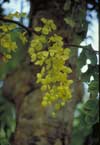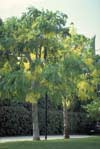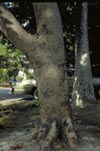Home >
Cassia fistula, Golden Shower Tree
Golden-Shower tree grows well in full sun on well-drained soil. Although Golden-Shower is damaged by temperatures falling slightly below freezing, it will come back with warmer weather. Sprouts may develop along the main branches in response to this low temperature. Like some other trees, fruit may be poisonous if ingested. Pollen can cause some allergies in certain people.
Trees will require pruning when they are young to control shape, to develop a uniform crown and to create good structure. Young trees can grow asymmetrical with branches often drooping toward the ground. Staking when the tree is young and proper pruning will help develop a well-shaped and well-structured crown but do not expect it to grow like a neat "meat ball". Trees are tolerant of urban conditions and have performed well as street and park trees.
Trees in their native forest habitat typically have one leader or trunk for several dozen feet, then trunks divide into several codominant stems toward the top of the tree. Unless properly pruned, trees in more open landscapes develop several codominant stems fairly close to the ground. These could become weak and split if structural pruning is neglected.
Plant serves as host for Cloudless sulfur (Phoebis sennae), orange-barred sulfur (Phoebis philea), and sleepy orange (Eurema nicippe) butterfly larvae.






